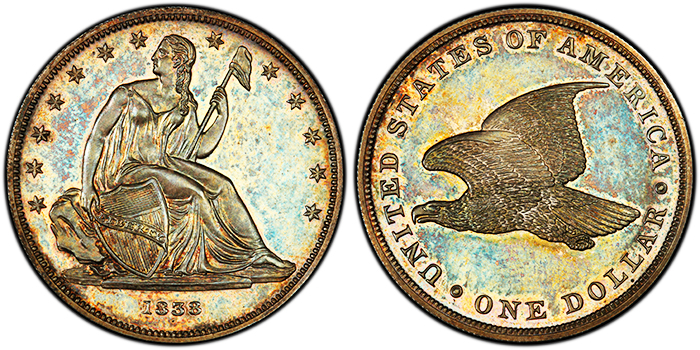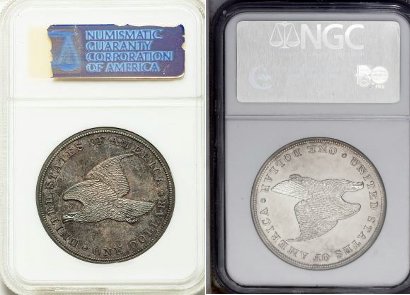Originals - struck sometime after July 1838. Exactly when these were struck is unknown as there are no letters from Director Patterson to Secretary of the Treasury Levi Woodbury concerning the design or mentioning samples. We do know that it took place sometime after July 1838 as Woodbury writes twice that month requesting more samples of the dollars and Patterson responds, sending him pieces leftover from the December 1836 striking. The records only contain Patterson's response to the first request, and in that he notes he is not satisfied with the look of the eagle. This fits with the discovery by Saul Teichman that the neck feathers were modified on the new Starless reverse.
|
State A - Mint Cabinet/Smithsonian, alignment IV. This piece is extremely hairlined, thus it is very difficult to see the details clearly. In fact, it may be the same state as the following ANS/Eliasberg piece.
NO RUST on Liberty, eagle, or letters - particularly note eagle's beak which is very granularity on Restrikes (see Restrike photos below for examples of rusting).
Obverse: Earliest seen with a small lump below elbow and perhaps some light rippling in right field opposite forearm from clash. Dash-like die line between Stars 9 & 10 angled up to right pointing at 2nd dentil left of point of S10 - this is seen on all states.
Reverse: Likewise earliest seen with a few small die lumps betweenTA. Very faint ITE and ME cracks. Note that 15X or higher magnification is required to clearly see these cracks.
Make sure you check the eagle's beak and letters for the graininess seen in the photos below before you decide you have an Original. Given the rarity of J84 Originals and the difficulty of establishing definitive die state markers for Originals, please contact Craig Sholley and/or John Dannreuther if you think you have an Original. |
Select |
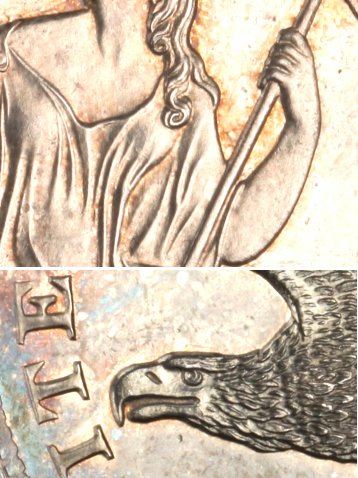 |
| |
State B - ANS/Eliasberg, alignment III.
NO RUST on Liberty, eagle, or letters -same as State A. The key difference between States A and B is the light clashing behind the eagle's wing in State B (note that image is in false color to highlight clashing).
Obverse: Small lumps between S10/11, dash-like defect between S9 and 10 and a few indistinct clash and/or polish lines in field to right of space between elbow and thigh - approx. midway between knee and wrist.
Reverse: A few small lumps between TA of STATES caused by clashing and corresponding to Star 10. Very faintly cracked at TE, MER, and LAR. Develops an elongated lump or wrinkle above SO near dentils. Very light horizontal polish lines from NITED to field around eagle’s head throat, and front of left wing. Scattered light die lines and clash marks behind wing.
Make sure you check the eagle's beak and letters for the graininess seen in the photos below before you decide you have an Original. Given the rarity of J84 Originals and the difficulty of establishing definitive die state markers for Originals, please contact Craig Sholley and/or John Dannreuther if you think you have an Original. |
Select |
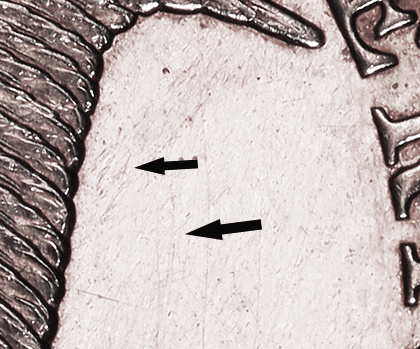 |
| |
Restrikes |
Early State Restrikes, Struck circa June 1859 to 1863. The emission sequence combined with historical records shows that the early J84 restrikes were struck circa 1859 to 1863 by Director of the Mint James Ross Snowden in trade for Washingtonia for the Mint Cabinet Collection. Auction prices show that additional early restrikes continued to appear through 1862 and 1863, likely by Linderman, et al, who were restriking various pieces for profit.
Rusty area below elbow and out into right field. Liberty granularity with numerous small rust lumps. The earliest restrikes have an "X scratch" in right field from forearm to thigh.
Obverse: Rusty area below elbow and out into right field. Liberty granularity with numerous small rust lumps.
Reverse: Larger area of lumps between tops of TA of STATES caused by additional clashing during striking of the 300 1839s in December of that year. Letters granularity from rusting with rust pits on upright and upper curve D United particularly noticeable on sharp strikes. Strong arcing polish lines through UNITED STATES OF AMERICA. “Die line” (actually a crack – see late state J104 Originals) from second dentil over T to left upper serif of E in UNITED. This reverse state is approximately the same as the latest state of 1839 Originals, now rusted. Both obverse and reverse show polishing lines, with the reverse being heavier. |
Select |
 |
| |
Middle State Restrikes. The emission sequence combined with historical auction prices shows that the mid-state J104 restrikes were struck circa 1867 to 1869 by Linderman, et al, just before the copper and mule Cabinet Coins.
Both dies finely polished to remove deeper rusting with "X scratch" now gone and the left rocky base at ribbon reduced by the polishing. Letters and eagle granularity from rust, especially noticeable on eagle's beak and head.
Obverse: Top portion of left rocky base at junction with upper rock and ribbon tip almost polished away. Liberty polished removing many rust pits, but pitting still visible through drapery and frequently on arms and legs. Rust patch below elbow is gone.
Reverse: Lumps at TA reduced by polishing and gone or nearly so on some pieces. Seen with light and heavy clash marks behind eagle’s wing. “Die line” (actually a crack) from second dentil over T to left upper serif of E in UNITED, may be weakened by polishing, but visible on sharply struck pieces. Letters granularity from rusting with rust pits on upright and upper curve D United particularly noticeable on sharp strikes. |
Select |
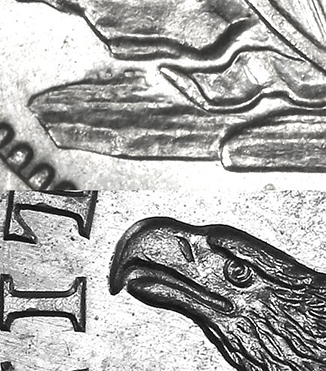 |
| |
Late State Restrikes. The emission sequence combined with historical auction prices shows that the mid-state J104 restrikes were struck circa 1873 to 1869 by Linderman, et al, just before the copper and mule Cabinet Coins.
Polishing further reduces rust and top of left rocky base nearly gone from polishing. Eagle's beak a bit less granularity. Late state pieces typically have more reflective fields than middle state pieces due to the additional polishing.
Obverse: Top of rocky base almost gone from polishing, leaving only a couple dots as remnants. Some light lines around elbow and in right field as remnants of clash.
Reverse: Reverse polished with lumps at TA reduced and gone or nearly so on some pieces. Seen with both heavy clashing and later polishing that leaves just traces of clashing behind eagle's wing. “Die line” (actually a crack) from second dentil over T to left upper serif of E in UNITED, may be weakened by polishing, but visible on sharply struck pieces. |
Select |
 |
